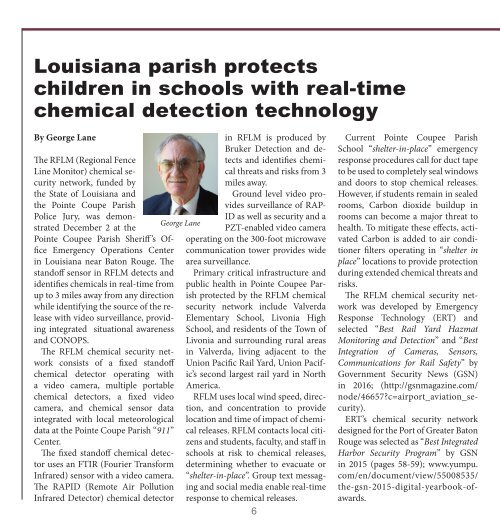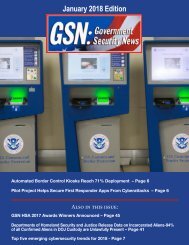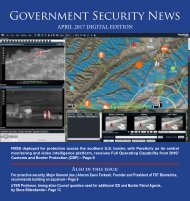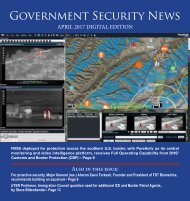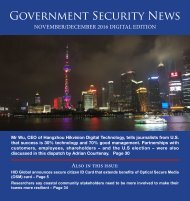Government Security News January 2017 Digital Edition
Government Security News January 2017 Digital Edition. Available on the GSN Magazine Website at www.gsnmagazine.com
Government Security News January 2017 Digital Edition. Available on the GSN Magazine Website at www.gsnmagazine.com
Create successful ePaper yourself
Turn your PDF publications into a flip-book with our unique Google optimized e-Paper software.
Louisiana parish protects<br />
children in schools with real-time<br />
chemical detection technology<br />
By George Lane<br />
The RFLM (Regional Fence<br />
Line Monitor) chemical security<br />
network, funded by<br />
the State of Louisiana and<br />
the Pointe Coupe Parish<br />
Police Jury, was demonstrated<br />
December 2 at the<br />
Pointe Coupee Parish Sheriff ’s Office<br />
Emergency Operations Center<br />
in Louisiana near Baton Rouge. The<br />
standoff sensor in RFLM detects and<br />
identifies chemicals in real-time from<br />
up to 3 miles away from any direction<br />
while identifying the source of the release<br />
with video surveillance, providing<br />
integrated situational awareness<br />
and CONOPS.<br />
The RFLM chemical security network<br />
consists of a fixed standoff<br />
chemical detector operating with<br />
a video camera, multiple portable<br />
chemical detectors, a fixed video<br />
camera, and chemical sensor data<br />
integrated with local meteorological<br />
data at the Pointe Coupe Parish “911”<br />
Center.<br />
The fixed standoff chemical detector<br />
uses an FTIR (Fourier Transform<br />
Infrared) sensor with a video camera.<br />
The RAPID (Remote Air Pollution<br />
Infrared Detector) chemical detector<br />
George Lane<br />
in RFLM is produced by<br />
Bruker Detection and detects<br />
and identifies chemical<br />
threats and risks from 3<br />
miles away.<br />
Ground level video provides<br />
surveillance of RAP-<br />
ID as well as security and a<br />
PZT-enabled video camera<br />
operating on the 300-foot microwave<br />
communication tower provides wide<br />
area surveillance.<br />
Primary critical infrastructure and<br />
public health in Pointe Coupee Parish<br />
protected by the RFLM chemical<br />
security network include Valverda<br />
Elementary School, Livonia High<br />
School, and residents of the Town of<br />
Livonia and surrounding rural areas<br />
in Valverda, living adjacent to the<br />
Union Pacific Rail Yard, Union Pacific’s<br />
second largest rail yard in North<br />
America.<br />
RFLM uses local wind speed, direction,<br />
and concentration to provide<br />
location and time of impact of chemical<br />
releases. RFLM contacts local citizens<br />
and students, faculty, and staff in<br />
schools at risk to chemical releases,<br />
determining whether to evacuate or<br />
“shelter-in-place”. Group text messaging<br />
and social media enable real-time<br />
response to chemical releases.<br />
6<br />
Current Pointe Coupee Parish<br />
School “shelter-in-place” emergency<br />
response procedures call for duct tape<br />
to be used to completely seal windows<br />
and doors to stop chemical releases.<br />
However, if students remain in sealed<br />
rooms, Carbon dioxide buildup in<br />
rooms can become a major threat to<br />
health. To mitigate these effects, activated<br />
Carbon is added to air conditioner<br />
filters operating in “shelter in<br />
place” locations to provide protection<br />
during extended chemical threats and<br />
risks.<br />
The RFLM chemical security network<br />
was developed by Emergency<br />
Response Technology (ERT) and<br />
selected “Best Rail Yard Hazmat<br />
Monitoring and Detection” and “Best<br />
Integration of Cameras, Sensors,<br />
Communications for Rail Safety” by<br />
<strong>Government</strong> <strong>Security</strong> <strong>News</strong> (GSN)<br />
in 2016; (http://gsnmagazine.com/<br />
node/46657?c=airport_aviation_security).<br />
ERT’s chemical security network<br />
designed for the Port of Greater Baton<br />
Rouge was selected as “Best Integrated<br />
Harbor <strong>Security</strong> Program” by GSN<br />
in 2015 (pages 58-59); www.yumpu.<br />
com/en/document/view/55008535/<br />
the-gsn-2015-digital-yearbook-ofawards.


